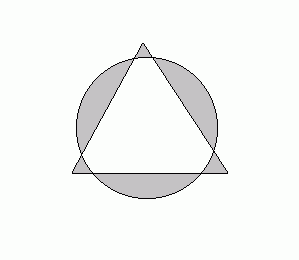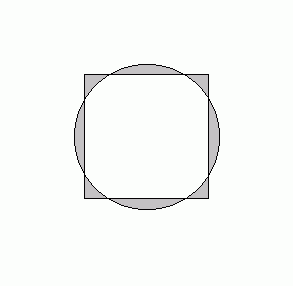 Author
Author |
Topic: Overlapping Circle and Triangle (Read 3757 times) |
|
ThudnBlunder
Uberpuzzler
    

The dewdrop slides into the shining Sea
Gender: 
Posts: 4489
|
An equilateral triangle of unit side length overlaps a circle of radius r centred at the centre of the triangle. What value of r will minimize the shaded area in the diagram?
|
|
 IP Logged IP Logged |

THE MEEK SHALL INHERIT THE EARTH.....................................................................er, if that's all right with the rest of you.
|
|
|
towr
wu::riddles Moderator
Uberpuzzler
    

Some people are average, some are just mean.
Gender: 
Posts: 13730
|
 |
Re: Overlapping Circle and Triangle
« Reply #1 on: Dec 14th, 2006, 3:47am » |
 Quote Quote  Modify Modify
|
Possibly, it's 1/3 . But after all the problems I encountered in my calculation, I'm not sure of anything at the moment.
|
| « Last Edit: Dec 14th, 2006, 3:47am by towr » |
 IP Logged IP Logged |
Wikipedia, Google, Mathworld, Integer sequence DB
|
|
|
Grimbal
wu::riddles Moderator
Uberpuzzler
    

I am sorry Dave, I *can* do that.
Gender: 
Posts: 7528
|
 |
Re: Overlapping Circle and Triangle
« Reply #2 on: Dec 14th, 2006, 5:47am » |
 Quote Quote  Modify Modify
|
I would say the same on the simple principle that the proportion of circle inside the triangle must be 1/2. When it is the case the increase of area outside the triangle matches the decrease of area inside the triangle when the radius increases infinitesimally. Geometrically you find a diameter of 2/3.
|
| « Last Edit: Dec 14th, 2006, 7:51am by Grimbal » |
 IP Logged IP Logged |
|
|
|
ThudnBlunder
Uberpuzzler
    

The dewdrop slides into the shining Sea
Gender: 
Posts: 4489
|
Well done, Grimbal. An astute observation. As usual toiling towr is also right. 
How about if we replace the triangle with a square?
With a regular n-gon?
|
| « Last Edit: Dec 14th, 2006, 7:10am by ThudnBlunder » |
 IP Logged IP Logged |

THE MEEK SHALL INHERIT THE EARTH.....................................................................er, if that's all right with the rest of you.
|
|
|
towr
wu::riddles Moderator
Uberpuzzler
    

Some people are average, some are just mean.
Gender: 
Posts: 13730
|
 |
Re: Overlapping Circle and Triangle
« Reply #4 on: Dec 14th, 2006, 8:48am » |
 Quote Quote  Modify Modify
|
In general I get sqrt(2) cot( [pi] /n)/[2 sqrt(cos( [pi] /n) + 1)]
for larger n it's approximately n/(2 [pi]) ; or better yet n/(2 [pi]) - 1/( [pi]n)
|
| « Last Edit: Dec 14th, 2006, 9:06am by towr » |
 IP Logged IP Logged |
Wikipedia, Google, Mathworld, Integer sequence DB
|
|
|
ThudnBlunder
Uberpuzzler
    

The dewdrop slides into the shining Sea
Gender: 
Posts: 4489
|
 |
Re: Overlapping Circle and Triangle
« Reply #5 on: Dec 14th, 2006, 12:34pm » |
 Quote Quote  Modify Modify
|
That's right, towr!
Slightly simpler is (1/2)*cot(pi/n)sec(pi/2n)
How did you get your 1/n(pi) refinement?
Also, the optimal circle has equal arc lengths inside and outside of the n-gon for all n.
|
| « Last Edit: Dec 15th, 2006, 1:04pm by ThudnBlunder » |
 IP Logged IP Logged |
THE MEEK SHALL INHERIT THE EARTH.....................................................................er, if that's all right with the rest of you.
|
|
|
towr
wu::riddles Moderator
Uberpuzzler
    

Some people are average, some are just mean.
Gender: 
Posts: 13730
|
 |
Re: Overlapping Circle and Triangle
« Reply #6 on: Dec 14th, 2006, 12:49pm » |
 Quote Quote  Modify Modify
|
on Dec 14th, 2006, 12:34pm, THUDandBLUNDER wrote:| How did you get your 1/n(pi) refinement? |
|
I guessed 
I plotted the difference and saw a hyperbola, and I tried a few values, pi seemed a nice one to leave it at.
Possibly a taylor series could find a better justified fit.
|
| « Last Edit: Dec 14th, 2006, 12:51pm by towr » |
 IP Logged IP Logged |
Wikipedia, Google, Mathworld, Integer sequence DB
|
|
|
Eigenray
wu::riddles Moderator
Uberpuzzler
    

Gender: 
Posts: 1948
|
 |
Re: Overlapping Circle and Triangle
« Reply #7 on: Dec 14th, 2006, 10:05pm » |
 Quote Quote  Modify Modify
|
You would expect r ~ n/(2pi) since the circumference ~ n. In fact,
r = n/(2pi) - 5pi/(48 n) - 293pi3/(11520 n3) - ...
But lets flip it around: fix the radius of the circle at 1, and vary the polygon. Then the inradius is
r = cos(pi/2n) = [1+cos(pi/n)]/2,
and if R is the circumradius, then
rR = [1+sec(pi/n)]/2,
and the area is
A = n[tan(pi/n) + sin(pi/n)]/2.
|
| « Last Edit: Dec 14th, 2006, 10:30pm by Eigenray » |
 IP Logged IP Logged |
|
|
|
|
 WRITE MATH!
WRITE MATH!
 Home
Home  Help
Help  Search
Search  Members
Members  Login
Login  Register
Register WRITE MATH!
WRITE MATH!
 Home
Home  Help
Help  Search
Search  Members
Members  Login
Login  Register
Register